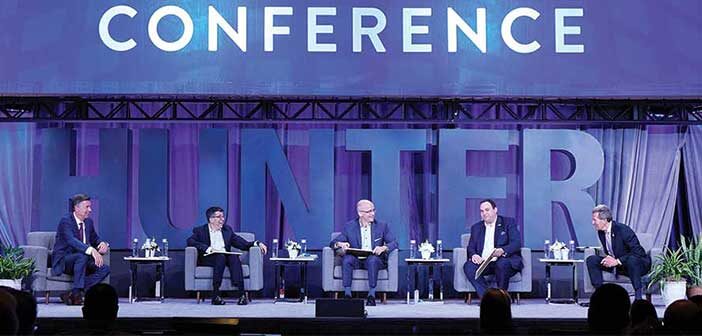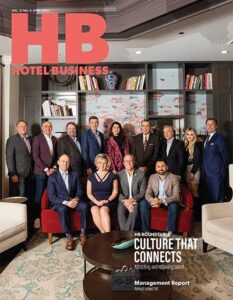The 33rd annual Hunter Hotel Investment Conference, held at the Atlanta Marriott Marquis, was filled with optimism—and many deals were discussed and made—as the industry moves forward on the path to recovery.
The first day was highlighted by the “C-Suite Conversations” session, moderated by Chip Rogers, president/CEO, American Hotel and Lodging Association (AHLA), and featured panelists Geoff Ballotti, president/CEO, Wyndham Hotels & Resorts; Tom Buoy, interim CEO/EVP, chief commercial officer, Radisson Hotel Group Americas; George Limbert, CEO, Red Roof; and Rob Palleschi, CEO,
G6 Hospitality.
Since the day kicked off with a discussion led by Castell Project’s Peggy Berg on topics impacting women in the industry, Rogers asked the panelists, “How does this industry do a better job of making sure that the 57% of our employees which are women soon become at least half of the leadership in our industry?”
Palleschi was the first to respond: “I think it has to start at the property level. How are we enabling a diverse workforce [and]a diverse leadership at our properties, promoting them to general managers [or]regional positions, and moving them up to the corporate office? It starts with a grassroots effort.”
Buoy pointed out that at Radisson Hotel Group Americas, 60% of the associates in the corporate office and 40% of the senior leadership team are female.
He added, “When you look across industries, at Fortune 500 companies, those companies that have over 30% of their senior leadership team are indeed outperforming those that do not. It’s the right thing to do, and we continue to have employee resource groups that focus on women in leadership and obviously strive to do better every day.”
Red Roof has set a goal to have 40% of its franchises be led by women in the next five years. “We’re doing that through development incentives and programs, but we really want to be one of the leaders in the industry as it relates to [female leadership],” said Limbert.
Ballotti noted that nine out of every 10 developers in the industry are men, adding, “It’s incumbent upon us as we look at this panel, and we say to ourselves, ‘Where are the women?’ But it begins with having ourselves surrounded by women and making sure that they’re up here on stage next year or the year after.”
Rogers then asked the panel and the audience to choose the biggest challenge presently facing the industry: workforce shortages, inflation, a slow return of business travel or supply chain challenges.
While most of the panel chose the labor problem, Limbert had a completely different answer.
“The failure to embrace the spirit of innovation is our number-one industry challenge,” he said. “Innovation and technology will help us solve the workforce issue and help us solve some of the supply chain issues.”
G6 Hospitality is trying to solve the labor issue by raising pay and providing increased benefits without raising rates, despite those solutions not being beneficial to its owners.
“We’re not able to transfer that cost over to the customer through increased rates,” said Palleschi. “We are keeping pace with the market, but it’s not exceeding what we’re paying [our employees]. So, it’s impacting our owners’ profitability.”
Another part of the problem is that the hospitality industry is not thought of by some as a career path to take, noted Ballotti.
“People do not view this as the easiest place to work or the best place to work necessarily,” he said. “It was an issue before the pandemic…it’s been improving…but it is all our responsibility…to make sure that the young workforce out there views this as a place that we all viewed it as years ago.”
He added that the industry is not keeping up with others in terms of rate of pay. “Who we’re competing against right now are big-box retailers at $15-$25 an hour,” he said. “What matters most…is how we’re paying our people in our hotels. And I think, as an industry, we’ve underpaid.”
Rogers then moved on to ask both the panel and the audience which of four items is more important today for hotel employees than it was prior to the pandemic: signing bonuses, childcare, transportation or scheduling flexibility.
While scheduling flexibility won by a longshot, Ballotti chose signing bonuses, which “have for our franchisees been one of the most effective tools throughout this pandemic in terms of attracting our housekeepers, room attendants and guest service frontline agents.”
Both Limbert and Buoy chose flexibility. “In [this]day and age, with employees having the power that they do, you have to meet them where they are—you have to be flexible with their schedules,” said Limbert. “That solves the childcare issue and some other issues.”
Buoy said, “You have to create a flexible working environment in order to attract that audience. You can actually see marketplaces starting to evolve where you can look online and look up time slots and sign up to meet that need in a very competitive job market.”
Unlike the others, Palleschi chose childcare, noting, “The cost of it has skyrocketed, and it’s a contributing factor to our turnover. We may be able to get those team members in and make them content for a short period of time but, ultimately, it boils down to the cost or the unavailability.”
Brand talk
Later that day, a panel of chief development officers (CDOs) took part in the “Your Brand, Your Corporate Landscape” session. Moderated by Gregg Wallis, senior editor, Hotel Business, the panel included Matthew Hostetler, CDO, Red Roof; Phil Hugh, CDO, Radisson Hotel Group Americas; Brad LeBlanc, SVP/CDO, Best Western Hotels & Resorts; and Brian Quinn, CDO, Sonesta Hotels International Corporation.
During the pandemic, brands stepped up with monetary assistance to help their franchisees survive, and also relaxed some of their most stringent standards.
“We’re still helping those areas of the country that are still recovering from [the pandemic],” said Hugh. “The interesting part is you learned from it. We learned that you don’t have to have 30 items on your breakfast bar. We cut it back to five items and empowered the franchisee—the actual person that put the money into the hotel—to make the decision [of what to include]. Why do you need such a robust breakfast on an occupancy per night of 10%? So, they can flex when they need to…and still be within the standard.”
Best Western “stepped in with $65 million right out of the chute,” said LeBlanc. “Today, we’re still giving money back and fee relief as well in certain parts of the world. So, we made a big commitment and went all in for our members.”
Red Roof’s plan was to help its own franchisees, as well as owners who were contemplating joining one of the company’s brands.
“We provided a relief package not only for the current franchisee base, but we put together a package to keep franchisees considering Red Roof and bringing the deal flow in,” said Hostetler. “So, these particular packages for our current franchisees, they’ve obviously been lifted at this point.”
Another thing that occurred during the pandemic is brands upgraded technology both back and front of the house. It started a trend that will likely continue for years to come.
Quinn said that Sonesta takes a strategic approach with technology, adding, “We’re willing to innovate and try new things, but we don’t want to necessarily do it just because everyone else is doing it or to go first, because you can get burned with the ridiculously expensive TV that’s in your basement.”
Red Roof is “being very conscious of the cost of implementation, making sure that if we’re going to get into something of this type of matter that it’s going to be done right,” noted Hostetler.
Hugh pointed out that the new Radisson Inn & Suites brand, which was introduced at the conference, will have a gaming center. “It’s something we think that will attract guests to the hotel and allow a more of a place to meet rather than just the breakfast area,” he said.
Quinn emphasized that brands must understand that some of the older technology may be outdated.
“For a while, we all thought we needed huge hotel signs because there was a segment of the traveler that didn’t have a smartphone that we wanted to see the sign and pull over,” he said. “If there [are people that don’t]have a smartphone post-COVID, it’s got to be an incredibly small percentage [of the population]. So, then, should we still be encouraging our owners to buy $60,000, $70,000 and $100,000 signs?”



